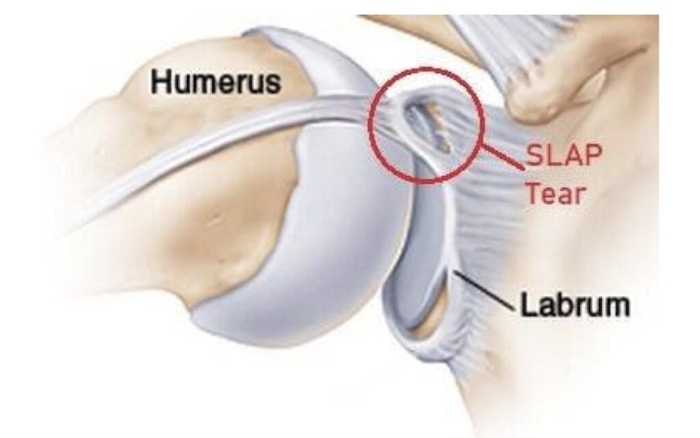
Tears to the specialized cartilage tissue in the shoulder known as the labrum can cause pain and instability in the shoulder.
What Is The Shoulder Labrum?
The labrum is a cup-shaped rim of cartilage that lines and reinforces the ball-and-socket joint of the shoulder. The shoulder joint is composed of the glenoid (the shallow shoulder "socket") and the head of the upper arm bone known as the humerus (the "ball").
The labrum is the attachment site for the shoulder ligaments and supports the ball-and-socket joint as well as the rotator cuff tendons and muscles. It contributes to shoulder stability and, when torn, can lead to partial or complete shoulder dislocation.
What Does A Torn Shoulder Labrum Feel Like?
The most common symptoms of a torn shoulder labrum are shoulder pain, instability, and, in some cases, a feeling of grinding, locking, or catching while moving the shoulder. These symptoms may vary depending on the type of labral tear a person has.
What are the different types of shoulder labral tears?
The two most common types of labral injuries are the SLAP tear and Bankart tear. Tears are usually accompanied by aching pain and difficulty performing normal shoulder movements.
SLAP Tears - SLAP stands for "superior labrum from anterior to posterior." This type of tear occurs at the front of the upper arm where the biceps tendon connects to the shoulder. "Athletes most prone to this injury include baseball pitchers and volleyball players who engage in high-energy, quick-snap motions over the top of the shoulder," Patients with SLAP tears may experience pain at the front of the shoulder near the biceps tendon.
Bankart Tears - Bankart tears typically occur in younger patients who have dislocated their shoulder. When the shoulder joint ball slips out of the socket, the joint capsule (fibrous tissues surrounding and protecting the joint) can pull on the lower portion of the labrum and tear it. This in turn creates instability because the breached labrum makes it easier for the shoulder to dislocate again. A dislocation where the head of the humerus shifts toward the front of the body leads to "anterior instability." When the ball slips toward the back of the body, it leads to "posterior instability."
With Bankart tears, patients may feel apprehension that the shoulder may slip out of place or dislocate in certain positions.
Can Labral Tears Of The Shoulder Be Prevented?
Unfortunately, labral tears are hard to prevent, especially in athletes, because the force of the overhead motion contributes to the injury. Although athletes are most prone to labral tears, people who experience a traumatic event – such as falling down a flight of stairs – are also at risk. This is especially the case in older adults because our cartilage becomes more brittle with age.
Can A Shoulder Labral Tear Heal Without Surgery?
In some cases, the labrum can heal with rest and physical therapy, depending on the severity of the tear. "Surgeons should try to be as conservative as possible when treating a torn shoulder labrum." Surgeons will usually conduct a physical exam and order MRI or X-ray imaging, if necessary, to determine the severity of the injury and the appropriate treatment.
SLAP tears are usually treated with rest, anti-inflammatory medications, and, in some cases, an in-office cortisone injection. This is followed by gradual stretching of the shoulder, initially with a physical therapist, for six weeks to two months.
If the injury is a minor Bankart tear with a dislocation, the physician (or even a team coach or patient themselves) can usually pop the shoulder back into place – a process called reduction – and then follow up with physical therapy to strengthen the muscles.
When Do You Need Surgery For A Torn Shoulder Labrum?
Surgery may be required if the tear gets worse or does not improve after physical therapy. "If physical therapy fails and the athlete still can’t complete overhead motions, or the shoulder continues to dislocate, surgical treatment might be required to reattach the torn ligaments and labrum to the bone." Arthroscopic procedures, in which the doctor operates through a small incision, are usually preferred because they are less invasive than open surgery.
In general, nonsurgical treatment is usually most appropriate for older patients who do not engage in regular physical activity, while younger athletes who regularly participate in higher-impact sports can expect recurrence and may want to consider arthroscopic surgery.
What Is The Recovery Time For Shoulder Labrum Repair Surgery?
Patients who undergo arthroscopic repair can expect shorter recovery times and less pain. Those undergoing open surgery should expect more pain, longer recovery, and in some cases incomplete shoulder rotation. Athletes may require six months to one year for full recovery, with overhead-throwing athletes taking the longest.
Regardless of which type of surgery is performed, almost all athletes are advised to wear a sling for the first four weeks after surgery to protect the shoulder as it heals.
Precision Pain Care and Rehabilitation has two convenient locations in Richmond Hill – Queens, and New Hyde Park – Long Island. Call the Queens office at (718) 215-1888 or (516) 419-4480 for the Long Island office to arrange an appointment with our Interventional Pain Management Specialist, Dr. Jeffrey Chacko.















